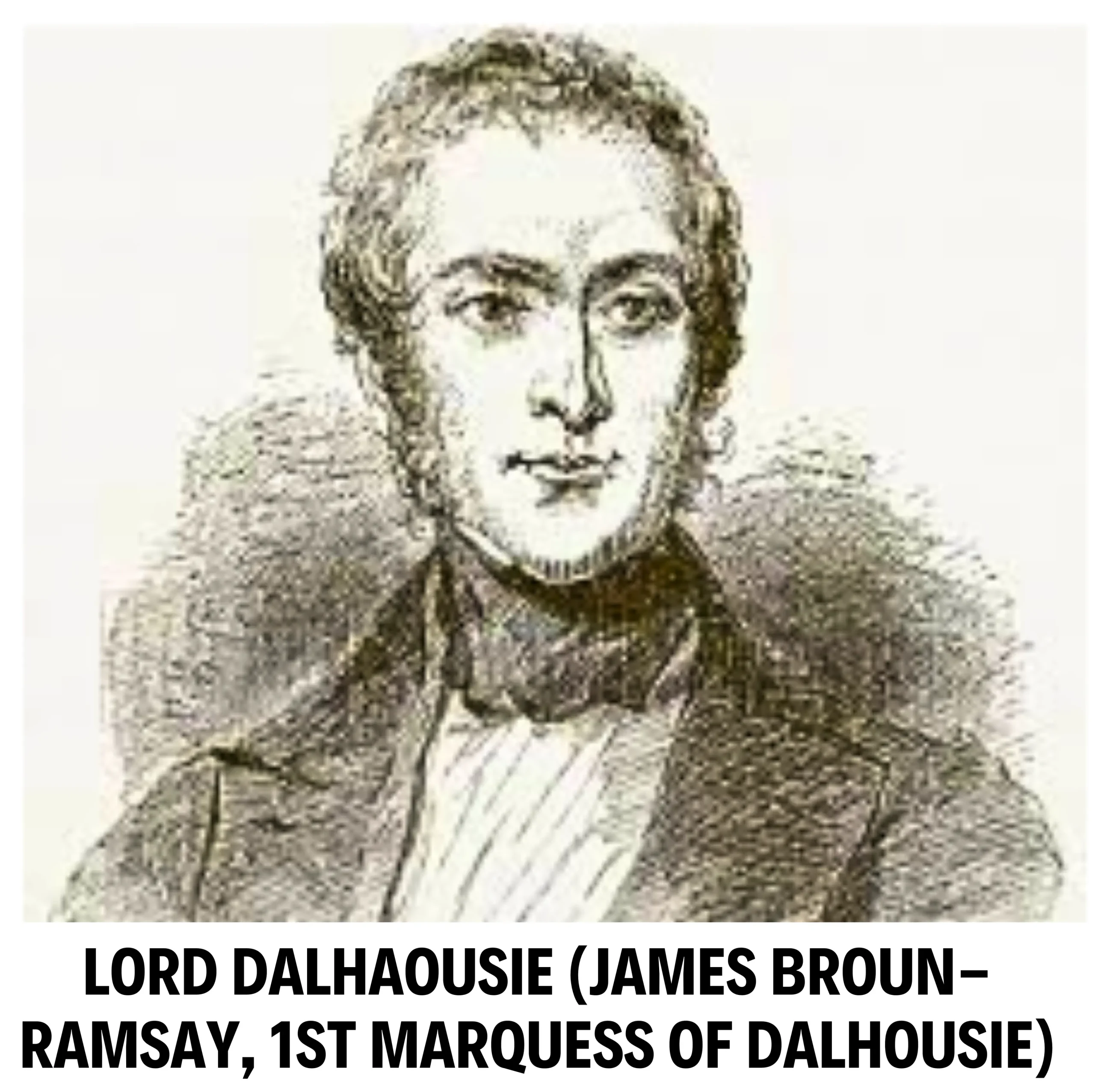Introduction to the Lord Dalhaousie (James Broun-Ramsay, 1st Marquess of Dalhousie)
Lord Dalhousie was the Governor General of India during 1848 to 1856. He introduced the Doctrine of Lapse policy which resulted in one of the major causes of the Revolt of 1857. By using the doctrine of lapse, he annexed numerous states.
During his tenure, the first railway line connecting Bombay and Thane was inaugurated in 1853, and the following year, a telegraph link was established between Calcutta and Agra. He also instituted P.W.D. and passed the Widow Remarriage Act (1856), among other measures.
Lord Dalhousie In Britain
Lord Dalhousie, born James Andrew Broun-Ramsay, belonged to a Scottish family. He was born to George Ramsay (9th Earl of Dalhousie) and his wife.
- He received his education at Harrow School and Christ Church College, Oxford.
- In 1837, Lord Dalhousie entered active politics and was elected to the House of Commons.

Lord Dalhousie In India
On 12th January 1848, Lord Dalhousie was appointed as the Governor-General of India and Governor of Bengal. He landed in India with an aim of consolidation of British power in India. Dalhoausie was known to be one of the hard workers but was also authoritarian and tough.
- Lord Dalhousie is controversially remembered for the Doctrine of Lapse policy. This policy is often blamed for triggering the Indian Revolt of 1857.
- His tenure saw some crucial conquest within Indian states and some foreign states.
- He initiated the establishment of Anglo-vernacular schools and implemented social reforms like banning female infanticide.
- Despite the controversy, many regard Lord Dalhousie as the ‘Maker of modern India” due to his social welfare decisions and modern reforms.
Various Conquest During Lord Dalhousie Tenure
Dalhousie was designated as the Governor-General of India from 1848 to 1856. His service tenure was marked by several crucial wars and conflicts. Some of the important wars and events during his tenure include:
| War | Time Period | Outcome |
| Second Anglo-Sikh War | 1848-1849 |
|
| Second Anglo-Burmese War | 1852 |
|
Introduction of Doctrine of Lapse by Lord Dalhousie
Dalhousie established the Doctrine of Lapse, which prohibited such monarchs from adopting a son to ascend to their thrones and stated that the British would take over Indian nations if there was no natural heir.
- According to this doctrine, on account of the failure of natural heirs, sovereignty passes on to the British. Dalhauise found it a convenient way of extending the Company’s territories.
- However, this doctrine was not originally developed by Dalhousie.
- Satara was the first state annexed under the doctrine of lapse in 1848 and Awadh was the last state to be annexed under Doctrine of Lapse.
Lord Dalhousie as a Maker of Modern India
Lord Dalhousie introduced various modern reforms in India, including the development of railways, telegraph and postal networks, and public works. Let us look his some reforms:
| Administrative |
|
| Military |
|
| Education |
|
| Connectivity |
|
| Development Works |
|
Conclusion
He is credited for establishing East India Company dominance in India, laying the groundwork for its later governance, and assisting his successors in putting down the revolt by enacting prudent policies. He ruled India before the nation entered the Victorian Raj period of governance.
| Related Articles | |
| THE ENGLISH IN INDIA | GOVERNOR GENERAL OF BENGAL |
| AMENDING ACT OF 1781 | REGULATING ACT 1773 |
| WARREN HASTINGS: FIRST GOVERNOR GENERAL | SUPREME COURT |
Frequently Asked Questions (FAQs)
Q1. What did Lord Dalhousie’s growth from 1848 to 1856 entail?
Ans. By using the doctrine of lapse, he annexed numerous states. During his administration, the first railway line between Bombay and Thane was inaugurated in 1853, and the following year a telegraph link was established between Calcutta and Agra. He also instituted P.W.D. and passed the Widow Remarriage Act (1856), among other measures.
Q2. Which Indian state was the first to annex territory under the Dalhousie Doctrine of Lapse?
Ans. As there was no male heir present when the state’s king passed away in 1848, Satara became the first state to be annexed under the doctrine of lapse.
Q3. Which states came under the Doctrine of Lapse?
Ans. Satara (1848), Jaipur and Sambalpur (1849), Bhagat (1850), Udaipur (1852), Jhansi (1853), and Nagpur (1854) were the next states to be annexed under the Doctrine of Lapse.
Q4. Why is Lord Dalhousie famous for?
Lord Dalhousie, born on April 22, 1812, served as Governor General of India from 1848 to 1856. He is renowned for introducing a variety of modern reforms in India, such as railways, telegraph and postal networks, and public works. The Ganga Canal was completed during his tenure. However, he is most remembered for the Doctrine of Lapse policy, which many believe directly contributed to the Indian Revolt of 1857.
Q5. Who was the youngest Governor General of India?
Lord Dalhousie, whose real name was James Andrew Ramsay, became the youngest Governor-General of India in 1848, serving until 1856. During this period, the Second Anglo-Sikh War (1849) was fought, resulting in the defeat of the Sikhs and the successful annexation of Punjab to the British administration. He annexed many states through the Doctrine of Lapse. Notable achievements during his tenure include the opening of the first railway line between Bombay and Thane in 1853, the connection of Calcutta and Agra by telegraph in the same year, the establishment of the Public Works Department (P.W.D.), and the passing of the Widow Remarriage Act in 1856.
| Must Read | |
| NCERT Notes For UPSC | UPSC Daily Current Affairs |
| UPSC Blogs | UPSC Daily Editorials |
| Daily Current Affairs Quiz | Daily Main Answer Writing |
| UPSC Mains Previous Year Papers | UPSC Test Series 2024 |

 GS Foundation
GS Foundation Optional Course
Optional Course Combo Courses
Combo Courses Degree Program
Degree Program












